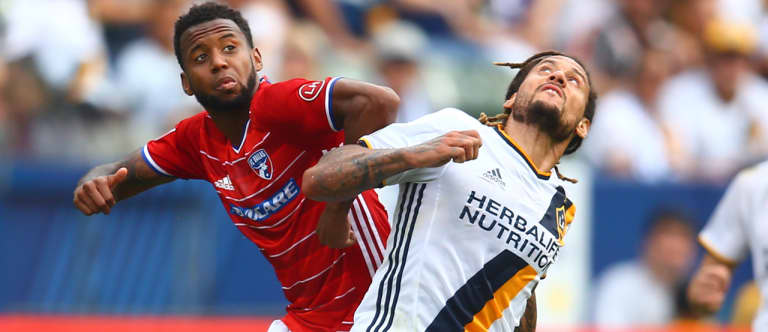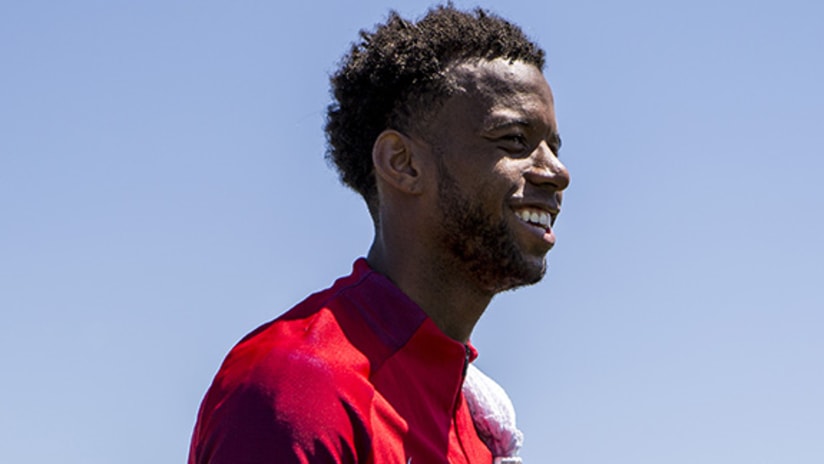In the 75th minute of the USA’s last World Cup qualifier, an important 1-1 draw in Panama that kept the World Cup qualification train tenuously back on the tracks, Kellyn Acosta jogged on for Jermaine Jones. You could almost see the eyebrows raising in concert from sea to sea.
Even an exceedingly conservative reading of the situation could see a modicum of ceremony in the substitution. Jones has been Michael Bradley’s preferred central defensive midfield partner since the heart of the qualification cycle for the 2014 World Cup. The two played off one another like a prototypical odd couple, Bradley acting as the taciturn defensive engine and Jones the enigmatic wanderer.
It worked, in its fashion, but after the 2016 Copa America Centenario the partnership clearly began to disintegrate. Jones had been asked to fill a nominal No. 10 role with the Colorado Rapids that year, giving him over to his baser attacking instincts and shearing off whatever defensive discipline was left. Meanwhile, the advancement of age and the build-up of an increasing number of injuries robbed him of his once tireless motor. What was left was a confusing mixture of attacking and defensive principles on a clear downslope.
Jones is a consummate pro, of course, but it was clear fairly quickly over the back half of 2016 that his best days were beyond him. The question was merely whether new US coach Bruce Arena had any reinforcements with which to replace him in time for the 2018 World Cup. And, most importantly, whether he could trust them with a World Cup qualifying campaign that needed rapid resuscitation.
Acosta’s sub on that cool equatorial night in March was essentially a trial balloon tipping Arena’s hand. Whether or not the US coach is ready to give the reins over to FC Dallas’ most impressive native son yet, it certainly seems as though that time is fast approaching. And make no mistake, it absolutely should be.
In fact, the time has never been better to start Acosta. Right now.
The big question

Acosta’s national team career leading up to that night in Panama had been a confusing mixture of positional mutability. Former US coach Jurgen Klinsmann seemed to think of Acosta as a fullback, which, to be fair, wasn’t a decision upon which he arrived out of the blue. Acosta had most often played on the defensive perimeter in his lengthy career with US youth national teams, and he’d been posted as a fullback as recently as the 2015 FIFA Under-20 World Cup. But his club career with FC Dallas told a different story, and club officials who knew his game intimately preached to anyone who would listen that Acosta was a central midfielder. Full stop, no questions asked.
Arena, gratefully, was receptive to the club’s gospel. Not long after taking over late in 2016, Arena was sure to allay any fears Acosta would be hidden at fullback by stating that he’d get his reps in the midfield. That cracked open the door for Acosta’s first ever World Cup qualifying appearance against Panama. You could almost see the FC Dallas hierarchy nodding its head in collective assent.
The problem with handing the keys over to Acosta at this tenuous point in the qualification cycle is sheer inexperience. The US can ill afford slips at this stage in the process. The Americans are currently fourth in the Hexagonal with six games left, one of which is the most difficult of the qualification process; away to Mexico in the Estadio Azteca in Mexico City on June 11. As is, fourth place is good enough for a World Cup playoff, and with results seemingly trending upward, the US is in a significantly better place to qualify outright than it was at the beginning of the year. Indeed, it’s probably a better bet than not.
Still, the US is in subsistence mode. Can you really afford to blood a player with six caps in that crucible? I’d say yes. And the reason is down to Acosta’s unique ability to jive with Bradley’s evolving puzzle piece.
Why Acosta fits in US midfield

I’d argue a significant part of the reason why Jones and Bradley’s tactical relationship has become so strained is largely down to Jones’ unpredictability. The LA Galaxy midfielder has always been a bit of a wild card, but his movement in the last year or so has become exceedingly hard to track.
His meandering created an obvious wall of dissonance between Jones and Bradley, who isn’t perfect but is so tactically metronomic that you can set a German train schedule by him. There have been more occasions than I can count when Bradley swept his cone of vision across his immediate vicinity and found Jones notably absent.
In its current construct, the US’s tactical game plan desperately needs Bradley’s partner to be a reliable connective tendon between its No. 6 and the attack. Whatever Bradley’s box-to-box role with Toronto FC, he’s settled into the defensive hole under Arena, meaning his partner determines – to an exceedingly high degree – how the US plays. Arena’s run a nominal 4-4-2 in the last two qualifiers. It risks becoming an empty bucket with another holder and another mutant formation entirely with a wanderer like Jones.
Acosta has the ability to become a true No. 8 on the international stage in a way no other player in the immediate senior team pool can. He can pinion opposing attacks alongside Bradley, which is important, but he’s also come into his own in 2017 as a surprising attacking cog in FC Dallas’ scheme.
Look at this seeing-eye pass he pulled off in FCD’s recent scoreless draw against the Houston Dynamo. Mauro Diaz’s extended injury layoff forced Acosta into more of an attacking role of late, which further diversified his skill set.
This sort of vision is not normal:
This is only one facet of Acosta’s game, of course, but it’s an important one. Acosta has vital linkage ability, and unlike Jones, he’s tactically consistent. Relying on Bradley as a key distributor isn’t ideal, and with Jones in the lineup the US ultimately ends up in that scenario. If Bradley is ultimately able to shuttle possession to a slightly higher Acosta while still using his midfield battery-mate for defensive help, the US will be significantly better for it in the long run.
So, will Bruce play him?

The Acosta question is really only tempered by experience. At such a pivotal juncture, can you really flip one of the keys to the midfield over to a 21-year-old? To wit, Arena’s done it before, giving Landon Donovan and DaMarcus Beasley their starts in the run-up to the 2002 World Cup. That’s not to say Acosta is the same player as either, or even fills the same position, but there is precedent. It isn’t such a wild notion.
And there will most likely never be a better time than now.
Acosta is in absolutely blistering form for FC Dallas, and the US has a favorable qualifier arriving on June 8. The US face Trinidad and Tobago in Colorado that day, and T&T are currently floundering in last place in the Hex.
That’s not to say it’ll be an easy affair – last place is only one point off the US, after all – but on home soil against an out-of-form team, the situation is ripe for Acosta to get his shot to pair with Bradley and make a case. And if it’s a good one? The Azteca awaits him on the other side.
As legendary Manchester United manager Alex Ferguson was fond of saying, if they’re good enough, they’re old enough. And Acosta is certainly good enough.














